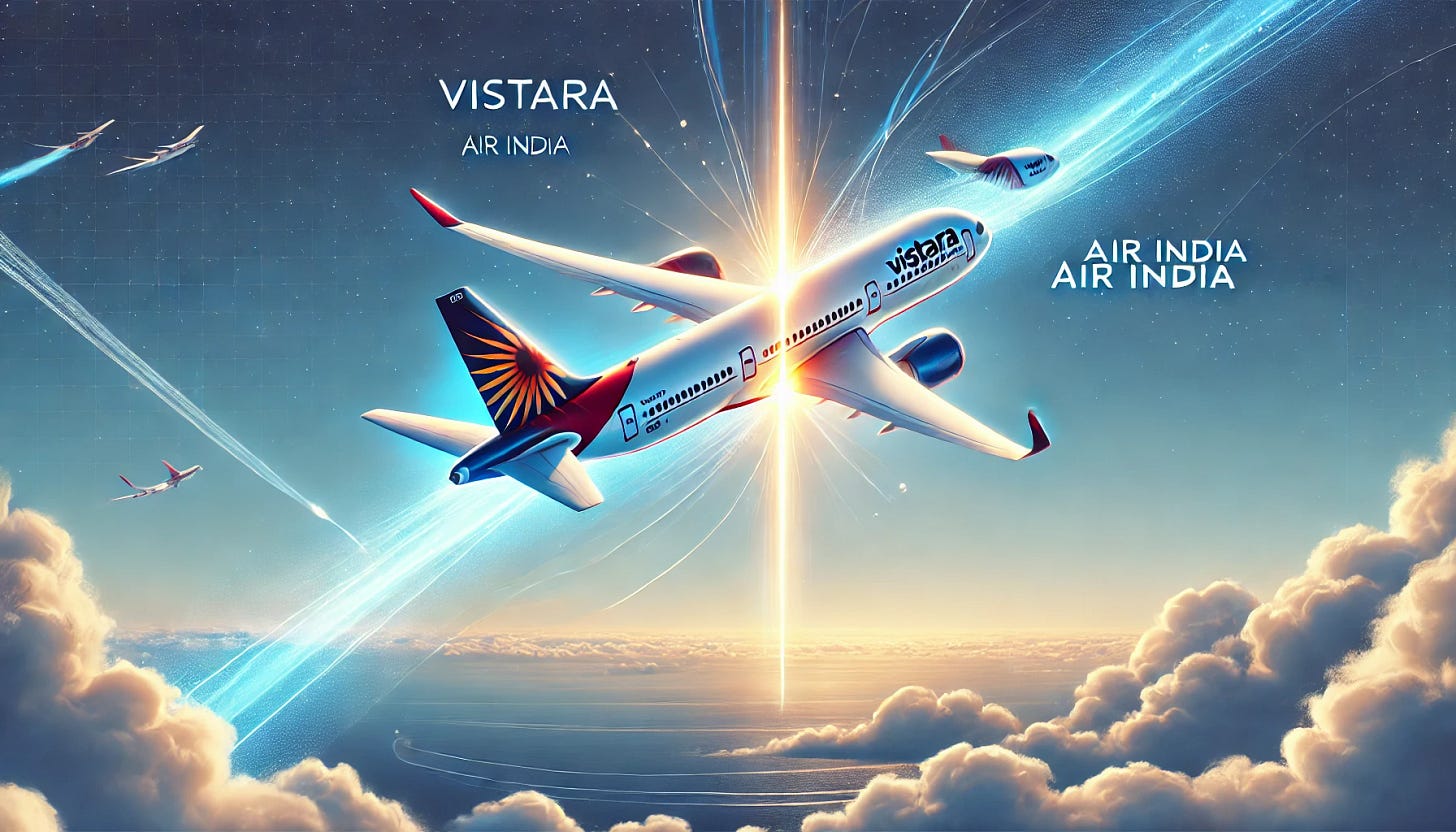Is The Vistara-Air India Merger A Good Idea?
let's find out
Welcome to a fresh new week and another exciting edition of Bharat.Inc! While Mondays might have a reputation for being “meh,” we’re here to turn it into a “YAY!”
But, before we start, remember:
Success is not the key to happiness. Happiness is the key to success
Now, let’s get started…
A love story or a power play?
You’ve probably heard the buzz: Vistara and Air India, two names we’ve all seen on boarding passes, are now flying under one banner. Yep, the merger is official. And while some are excited, others are clutching their boarding passes nervously. Let’s dive in and break it down.
Why is this merger a big deal?
Two airlines with very different vibes - one’s known for its top-notch service (hello, Vistara) and the other’s, well, a legacy that needs no introduction (Air India’s Maharaja tips his turban here). Together, they’re now a 208-aircraft powerhouse operating over 5,600 weekly flights to 90+ destinations.
Tata Group, which owns both airlines, says this merger is about creating a global leader in aviation. And honestly, when you combine Vistara’s premium aura with Air India’s global network, it sounds like a match made in...a very strategic boardroom.
But this isn’t just about planes and destinations. It’s about what we, the passengers, get from this shiny new airline marriage.
Why this merger could be awesome?
📌 One airline to rule them all
Air India’s strength has always been its global presence. You’ve probably seen their flights to London, New York, or even Sydney. Vistara, on the other hand, built its reputation on premium domestic and short-haul international flights.
Now imagine these two strengths combined. With Vistara’s world-class service standards blending into Air India’s extensive international network, this could be India’s answer to global giants like Emirates or Singapore Airlines. Finally, an Indian airline we can recommend to our international friends without nervously saying, “But, uh, the food’s good!”
📌 More flights, fewer layovers
Let’s be honest: nobody enjoys a layover, especially when it’s at a crowded airport with questionable Wi-Fi. This merger means an expanded route map with potentially more direct flights to key destinations.
Planning that long-overdue European getaway? Or a spontaneous trip to Southeast Asia? Chances are, you’ll have more options to get there faster. And yes, fewer layovers mean fewer overpriced airport sandwiches. So, it’s a win-win.
📌 Loyalty gets a glow-up
If you’ve been racking up points with Vistara’s Club Vistara program, don’t worry; they’re not going anywhere. They’ve just found a new home in Air India’s Maharaja Club. Your points will transfer 1:1, and you’ll still be able to upgrade your seats, snag lounge access, and feel like a VIP (even if it’s just for that extra legroom).
What’s exciting is the possibility of a supercharged loyalty program. Imagine earning points on more flights, redeeming them for cooler rewards, and accessing perks on a wider network. If you’re a frequent flyer, this merger might just feel like a gift wrapped in an in-flight blanket.
But why are some folks nervous?
📌 Will service standards slip?
Here’s the million-mile question: can Air India adopt Vistara’s boutique airline vibes? Merging two companies is tough, but when you throw in wildly different service cultures, it’s even trickier.
Air India’s known for its legacy, but let’s face it - it hasn’t exactly been winning awards for service excellence in recent years. The fear is that in trying to scale Vistara’s premium service across a much larger network, quality could take a hit. And let’s not forget that transitioning employees, fleets, and policies seamlessly is no small task.
📌 What about ticket prices?
Premium services often come with premium prices. If Air India takes Vistara’s luxury experience and spreads it across its network, it might mean higher ticket prices for us. And let’s be real: while I love good service, I also love a good deal.
Budget-conscious travelers might end up looking elsewhere (hello, IndiGo, and Akasa Air), leaving Air India to compete primarily in the premium space. Will that work in a price-sensitive market like India? We’ll have to wait and see.
📌 Competition is watching
While Air India is busy sorting out its new avatar, competitors like IndiGo and Akasa Air are sharpening their game. They already dominate the budget market, and they’re not going to hand over the premium segment without a fight.
This means we, as passengers, might see some aggressive pricing and better services from other airlines trying to lure us away. Not a bad time to be a traveler, right?
What do you think?
Does this merger excite you, or are you skeptical? Are you looking forward to premium services or worried about paying more for your ticket? Share your thoughts in the comment section.
So, that’s it for today! See you tomorrow 👋


